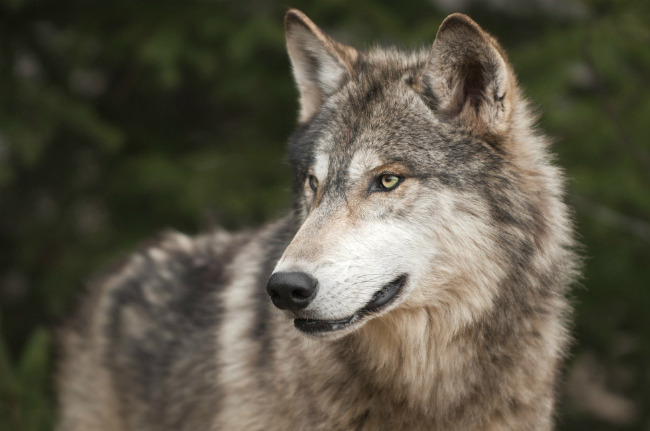As 2011 came to a close, a wolf that biologists call "OR-7" made history by loping across the Oregon border into Northern California. He was the first wild wolf seen in that state since 1924.
But that's only one of OR-7's milestones. Two months earlier, he became the first wolf in over 50 years to roam the western Cascades. As OR-7 rambles on, he invites us to join him on a classic Western odyssey.
OR-7 is two-and-a-half years old. He was born in the Wallowa Mountains of northeastern Oregon into the Imnaha Pack, one of Oregon's four reproducing packs. Last February, biologists fitted him with a GPS collar, and in September he left his family. By early 2012, he had walked close to 1,000 miles.
Biologists call him a "disperser," a youth so driven to find a mate that he leaves his natal pack. But as OR-7 keeps moving, it's easy to imagine that he's also driven by the kind of pioneering spirit that Westerners love to celebrate. As he faces down an unknown and dangerous landscape, we can recall how Lewis and Clark climbed the Bitterroots, how Theodore Roosevelt braved North Dakota's stinging weather on horseback, how young Native Americans undertook vision quests alone in the wilderness. We can picture a young Jack Kerouac balling a '49 Hudson for the Pacific Ocean. And don't forget traveling writer John Steinbeck and his wolf-descendent dog named Charlie.
Many of us modern-day transplants to the West see in OR-7 the same restless spirit that first inspired us to come to this rugged and beautiful landscape. OR-7, you could say, sometimes reminds us of ourselves.
Don't doubt that his journey has been brave and arduous. When he left his family, he abandoned safety, food security and a dependable place to find shelter and rest. From the bounty of the Wallowas, he wandered into the hardscrabble dust and sage of eastern Oregon's desert. There were rattlesnakes, cougars and hostile men with guns. Traversing a long loop, he probably survived on hares, grouse, maybe a few mice.
Southwest of Baker City, Ore., the wolf reached Interstate 84, a deadly oasis. Wounded or dead deer lay by the roadside, ready to eat. But he could have been killed in a flash, suffering the same fate as the young Yellowstone wolf that wandered 1,000 miles to Colorado in 2004, only to be killed by vehicles on Interstate 70.
Somehow, OR-7 made it across the interstate, perhaps just a blur in someone's headlights. Moving south, he wandered the length of the Malheur National Forest. Mountainous and forested, it was familiar terrain. Maybe that's why he veered west near Burns, sticking to forest rather than venturing into the arid lands stretching south.
In October, he was back in the high desert, now southeast of Bend. He backtracked east 20 miles, then swerved 40 miles south into Lake County before heading west again. Only he can explain the winding route he took. But it was hard, dry country, an extension of the Great Basin Desert, and like any of us, maybe he just wanted out of there.
Wolves live by their sense of smell, and something must have drawn OR-7 toward that major north-south range, the Cascades. By Halloween, he was spending frosty nights above 4,000 feet. It was hunting season, and maybe he lurked just beyond the glow of a campfire, listening to the stories. It was another warm fall in the Northwest, and successful hunters left behind plenty of meat for bears, cougars, magpies and perhaps a hungry young wolf.
At the first snows, OR-7 climbed the high country near Crater Lake, not far from where the last wolf in the Oregon Cascades was shot in 1947. He lingered for weeks among soaring peaks and tall trees that hadn't seen a wolf in decades. In mid-December, a biologist reported that OR-7 fed on an elk entangled in a fence. Then, like many a Western folk hero, he was suddenly on the move again, rambling south into the Siskiyous of California.
Wherever OR-7 goes, he brings back visions of a younger, wilder West. Trotting among tall trees, he startles complacent elk, who swiftly recede into the thick timber. That gives the streamside aspen shoots a chance to grow tall, shading the water for fish and extending limbs to beavers. Wolves alter the landscape they live in.
They also imprint on our imaginations. So I say: Keep going, OR-7. Shine on, you crazy wolf. I hope you successfully run the gantlet and make it to paradise. That could be the Trinity Alps or the Lost Coast of Cape Mendocino, or maybe inland to the sugar pines of the Sierras. Perhaps you'll make it all the way to New Mexico's Gila country, where you'll meet a female from one of those beleaguered packs of Mexican wolves.
That would really stir things up.
Tim Lydon works as a wilderness ranger in Alaska during the summer and lives in Montana during the winter.
To stay updated on OR-7's whereabouts, click here.
–
This essay originally appeared in High Country News.
